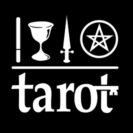The meaning of a single card will depend on what the reading is about, not necessarily what the standard divinatory is. The true secret of interpretation is that there have to be a minimum of two cards, using Elemental Dignities.
Twins
Twins have a relationship between each other dependent on their elemental nature. Analysing Pairs rely on similarity. This measure is quite crude, as you can see – in this example we do not know which is stronger, so the description is short.


Enemies, both weakened, Neutral.
Pairings need to have a product, a third, to define their relationship:
Three Cards: Two elements
Each is defined in terms of the other two, so a hierarchy is established in terms of strength, weakness, activity or passivity. With Three , the Centre assumes greater importance, and is known as the Principal . Where there are only two elements, the situation is still not satisfactory, so my description is only slightly longer than for two:



Excess Water, passive, they extinguish the centre card.
Three elements
Greater subtlety is now possible, since two elements will always be inimical to each other, with the third friends of both, creating a tension and dynamism that mirrors life to a greater extent.
Excess Water, passive, they extinguish the centre card.
Three elements
Greater subtlety is now possible, since two elements will always be inimical to each other, with the third friends of both, creating a tension and dynamism that mirrors life to a greater extent.



Three on an Elemental Position
Having an Elemental Position gives the opportunity to interact with the environment as well as themselves, which is a more realistic representation of life. In the example below, the influence of the ‘missing’ element Earth is judged.


Four
The dynamics of a four card spread are complex.



Two Principals, Fire and Water, surrounded by Air, which is friendly to both, so we can safely assume it is strongest, especially as the principals are inimical to each other. A person vacillating over whether to act or not, but would rather do something (there are 3 active elements).
Four elements on Elemental Positions
Putting four cards on an elemental position enables them to interact with their environment as well as between themselves. Below I give examples of the same cards in four elemental positions to show how excesses, weaknesses and strengths change dramatically.
On Fire




Water is weak – friendly but neutral to Air, while an enemy to Fire. Air is strengthened, but since Fire and Water are still enemies, we would expect some coercion or pressure to act in a certain way. Odds are that action takes place, but with some misgiving. The absence of Earth suggests impracticability, or that whatever action is taken, it does not last, or the results do not happen.
On Water




On Air




Excessive Air. Conflicts arising on whether to act or not. A committee meeting where nothing is resolved.
On Earth




Enemies abound. Air on Earth is weakening. Earth shows solidity, certainty, security, while Air is literally making cracks. Weakened Air surrounds Fire and Water, so Fire has no confidence in what to do. Everybody runs for cover and nothing happens.
Five Card Readings
Five Card Readings gives the opportunity to extend the concept of reading in groups of three. Since we know AFWA so well, let us insert Earth in the centre of the sequence.





Telling Tales
One problem solved, and another arises. Now that we have three ‘Principals’ we have the problem of knowing which one to interpret first; which direction do we go, and where do we end? The Golden Dawn comes to the rescue on this problem too: Card Counting. The possibilities are endless with this system, and it does not matter how many we have to read. Not only does the system tell the reader where to start the reading but in which direction, which card is next, and when to change direction, and so on; it even tells the reader when to stop! The cards that are ‘ignored’ have significance too, since they can represent sub-plots (or areas that the querent may be unaware of) within the story that is unfolding.Here is the concept of story-telling within Tarot, the combination of Elemental Dignities and Card Counting are sophisticated and powerful tools for the Tarot Reader. When I lay out a sequence, I start by looking at what sort are there: excess of an element, groups of Courts, absence of major arcana, etc, etc, and then I start counting from whatever significator to see how long the sequence is – whether it meanders, or bounces back and forth between courts, maybe the sequence “misses” cards representing issues important in the querent’s life, and so on. For example, if the question is “Will I go out with this man?”, and there is only one male court, but the card counting misses him, I would examine why it is being avoided, and I can suggest actions that might bring about success. Alternatively he might be there but he is unobtainable, and I can give reasons about why this might be so too. Now that I have presented a full overview of how to read Tarot using Elemental Dignities, feel free (if you have not already done so) to explore in detail the system in detail.

0 Comments